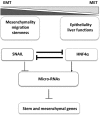Molecular mechanisms controlling the phenotype and the EMT/MET dynamics of hepatocyte
- PMID: 24766136
- PMCID: PMC4344819
- DOI: 10.1111/liv.12577
Molecular mechanisms controlling the phenotype and the EMT/MET dynamics of hepatocyte
Abstract
The complex spatial and paracrine relationships between the various liver histotypes are essential for proper functioning of the hepatic parenchymal cells. Only within a correct tissue organization, in fact, they stably maintain their identity and differentiated phenotype. The loss of histotype identity, which invariably occurs in the primary hepatocytes in culture, or in vivo in particular pathological conditions (fibrosis and tumours), is mainly because of the phenomenon of epithelial-to-mesenchymal transition (EMT). The EMT process, that occurs in the many epithelial cells, appears to be driven by a number of general, non-tissue-specific, master transcriptional regulators. The reverse process, the mesenchymal-to-epithelial transition (MET), as yet much less characterized at a molecular level, restores specific epithelial identities, and thus must include tissue-specific master elements. In this review, we will summarize the so far unveiled events of EMT/MET occurring in liver cells. In particular, we will focus on hepatocyte and describe the pivotal role in the control of EMT/MET dynamics exerted by a tissue-specific molecular mini-circuitry. Recent evidence, indeed, highlighted as two transcriptional factors, the master gene of EMT Snail, and the master gene of hepatocyte differentiation HNF4α, exhorting a direct reciprocal repression, act as pivotal elements in determining opposite cellular outcomes. The different balances between these two master regulators, further integrated by specific microRNAs, in fact, were found responsible for the EMT/METs dynamics as well as for the preservation of both hepatocyte and stem/precursor cells identity and differentiation. Overall, these findings impact the maintenance of stem cells and differentiated cells both in in vivo EMT/MET physio-pathological processes as well as in culture.
Keywords: EMT/MET; HNF4a; Hepatocyte; Snail.
© 2014 The Authors. Liver International Published by John Wiley & Sons Ltd.
Figures


References
-
- Torre C, Perret C, Colnot S. Molecular determinants of liver zonation. Prog Mol Biol Transl Sci. 2010;97:127–50. - PubMed
-
- Colletti M, Cicchini C, Conigliaro A, et al. Convergence of Wnt signaling on the HNF4alpha-driven transcription in controlling liver zonation. Gastroenterology. 2009;137:660–72. - PubMed
-
- Fausto N. Liver regeneration. J Hepatol. 2000;32(Suppl. 1):19–31. - PubMed
Publication types
MeSH terms
Substances
LinkOut - more resources
Full Text Sources
Other Literature Sources
Research Materials
Miscellaneous

